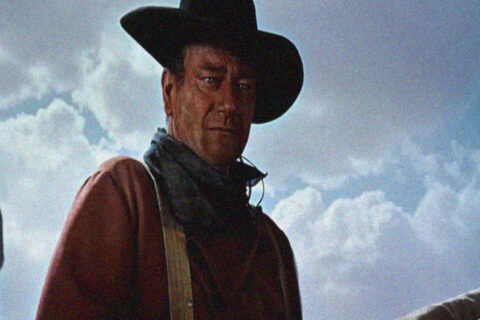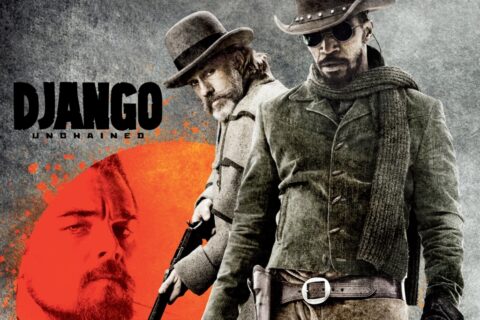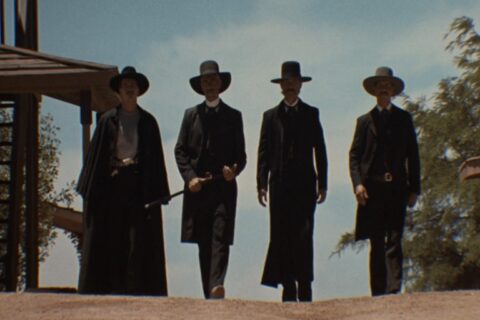Last evening, I started to watch a Western called A Man Called Sledge starring James Garner. About ten minutes into the movie, I got the distinct feeling that this was a European-made Western, at which point, my interest began to wane considerably. Anyone who knows me knows I don’t like “Spaghetti Westerns.” They lack the authenticity and feel of an American Western. I know everyone just raves about those three Spaghetti Westerns Clint Eastwood made, A Fistful of Dollars, The Good, Bad and the Ugly, and the other one which I can’t recall the name of. Of all Eastwood’s Westerns, these three were among my least favorite ones. To me, Outlaw Josey Wales, Joe Kidd, and Pale Rider were lots better and they “felt” like they took place in the American West and not 35 miles outside of Barcelona, or someplace in Yugoslavia.
Even James Garner didn’t like the Sledge movie. Supposedly he wrote in his autobiography that he didn’t know why he ever let Dino de Laurentius talk him into “making this turkey.” He said it was marketed as “…not fit for children. It should have been marketed as not fit for consumption.”
There’s just something about a European Western that doesn’t ring true to me. Often, it’s the scenery. Although they’ve got some terrific scenery in Europe, it’s not the American West. I have no problems with Westerns made in Mexico because much of their scenery is very much similar to our Southwest. The Sonora and Chihuahua Deserts occupy parts of both Mexico and the United States, and are great places for filming American Westerns, when any are even made anymore. I’ve been in both deserts, south of Texas and Arizona, and they contain some of the most beautifully rugged scenery in the world.
But, another problem with the European Westerns is the cultural mindset, which often makes them much more complicated than American Westerns. The Europeans don’t think like we do. That’s not intended to be overly critical of the mode of European thought – except when it comes to making American Westerns. As someone who loves Westerns, I am just not comfortable with a European Western. It “just don’t feel right.” I suppose that makes me provincial in some folk’s eyes, and if so, that’s fine. I’ve never claimed to be a “man of the world” and I’m not!
Having said all this, there are some American Westerns that don’t cut the mustard, either. I recall seeing one, Garden of Evil I think was the name of it, with Gary Cooper. It was about a group trying to rescue someone down in Mexico from Apache Indians. That would have been fine, except the Apache Indians in the movie were costumed like Mohawk Indians from New York State! There’s a wide variance between what Mohawks and Apache wore, but the movie’s producers apparently were ignorant of that. To them, an Indian was an Indian and they probably grabbed at the first picture of an Indian they came across and ran with that – erroneous though it was. You’d think some of these big bucks guys from Hollyweird could do a little more homework.
I’ve mentioned movie director John Ford in articles over the years. Although I didn’t always totally agree with his worldview, John Ford always got his Indians right. In his movies, Mohawks always looked like Mohawks and Apache always looked like Apache. Besides which, he filmed some of his Westerns in and near Monument Valley, right where Arizona and Utah come together, and it is some of the most rugged and beautiful Western scenery anywhere. My wife and I have been where he filmed some of his greatest Westerns and I have to say that, in that country, you can “feel” the American West – and that feeling comes through in Ford’s movies. They never would have had that impact had they been filmed in Italy or Spain!
Often, Hollyweird will screw up a Western because they are all about making money and not about authenticity. But one thing they can’t screw up, if they choose a good location, is the scenery. I’ve seen some really lousy Westerns filmed in great locations. If the movie is crummy, you can at least enjoy the good scenery. My wife and I can no longer travel. When we could, we went all over the country. Now all we can take is armchair vacations, but when we see a good authentic Western, and filmed in a great location, that is like sort of a mini vacation to us.
-By Al Benson Jr.

O I’m a good old rebel, now that’s just what I am. For this “fair land of freedom” I do not care at all. I’m glad I fit against it, I only wish we’d won, And I don’t want no pardon for anything I done.





Disagree. Most Hollywood Westerns are too moralistic and have become too woke, diverse and even corny. “Spaghetti Westerns” were good solid entertainment and it was the Italians who reinvigorated the American Westerns in the 60’s with Fist Full of Dollars.
The second movie in the Clint Eastwood spaghetti western trilogy was “For a Few Dollars More” co-starring Lee Van Cleef as Colonel Douglas Mortimer, “the best shot of the Carolinas” and as a former confederate officer, the hero of the movie. I remember several wretched American westerns made in the 60’s like Steve McQueen’s “Nevada Smith” that were putdowns of White Americans, with Jews Martin Landau and Karl Malden playing despicable villains who were supposedly white gentiles while blond headed Steve McQueen improbably played an American Indian, and was therefore the politically correct hero of the film. Also don’t forget “The Searchers” starring John Wayne . The message of that horse opera being ” honky, get used to miscegenation- your women really prefer nonwhite sexual partners, you’re getting replaced!” I frankly prefer Clint Eastwood’s spaghetti westerns to the Jewish anti-white propaganda that Hollywood churned out and labelled Westerns in the late 50’s and 60’s. Give me the old ones featuring Randolph Scott( a real southerner) , Audie Murphy(another real Southerner) and John Wayne( I’ll excuse him for “The Searchers”.
Pardon me, but Karl Malden was not a Jew, he was Serbian, and an Orthodox Christian.
Have to agree with the comments. The Fist Full of Dollars trilogy along with Once upon a Time in the West, all directed by Sergio Leone with haunting soundtracks by Ennio Moricone, are better than anything American directors did. John Wayne always made me cringe; he looked good and always seemed like the most sensible person in the crowd but as soon as someone disagreed with him he either beat hell out of the guy or shot him. An archetype for a Yankee driven foreign policy. Offscreen, he was an unrepentant war monger. Clint Eastwood, Charles Bronson, Lee Van Cleef played characters who were far more compelling.
Two American westerns, not well known, that I did enjoy were Monte Walsh starring Lee Marvin and Jack Palance, and Will Penny starring Charlton Heston.
I have o agree with you on Monte Walsh and Will Penny. Both were excellent Westerns.
Have to give a hat tip to “Shane” from 1953. Any movie that has a climatic gun-fight with the line “I’ve heard that you’re a low-down Yankee liar.” as the signal to start shooting works for me!
“Shane” was filmed in Wyoming and won an Academy award (back when that actually meant something) for Best Cinematography.
Pretty good movie if you have never seen it.
I have seen it and it was good, filmed with the Teton Mountains as a backdrop. And I also enjoyed Alan Ladd’s comment that started the fireworks.
Audie was from Hunt County Texas, grandson of a Confederate veteran. The sign on the Greenville city limits ( Hunt county seat) Wellcome to Greenville, the blackest land and the whitest people. Now in the county museum.
Haven’t commented on here much in awhile, but had to chime in for this
There’s aparently an entire genre of Soviet / Russian films called “osterns”, it means “Eastern” as opposed to Western, but the themes are fairly similar to the American idea of the Western. They’re generally set in the Caucasian Steppe / West Asian part of Russia and have similar themes
https://en.wikipedia.org/wiki/White_Sun_of_the_Desert
Dear” actually”- I agree with you about “Shane”- probably the best western ever made- and maybe the best film ever made period. Alan Ladd, who played Shane, was from Arkansas originally.
In all of John Wayne’s best Westerns he plays a Southerner without a Southern accent. In the classic “The Searchers,” about the Texas frontier people, there is not a single Southern accent except for one buffoon. In his worst role ever, in the earlier “Alamo,” Wayne plays Davy Crockett ridiculously. The real issue here is the Yankeefication of Western history which is mostly Southern in its most interesting aspects.
While I realize there were lots of Southern folks in the West during “reconstruction” (really deconstruction) not hearing Southern accents in western movies does not bother me nearly as much as other inaccuracies for the simple reason that when Hollyweird tried using Southern accents in movies they never quite seemed to get them right. There are lots o varied Southern accents and the average Virginian does not sound like the average West Texan and the movie makers never seemed to be able to match the accent with where their character was supposed to be from.
Robert Duvall once said, “America owns the western.” I’d add we also own the trucks, SUV’s and vans. However, American westerns can be divided into 3 parts. 1. The over homogenized early westerns. 2. The real good true ringing westerns. 3. Pretty much 3/4 of westerns made after about 1982 which have PC injected into them by the possessed Jews in control.
Having said that, all Eastwoods westerns are awesome and seem more real than the homogenized American ones EXCEPT Pale Rider, High Plains Drifter and of course the PC injected Unforgiven. There’s a lot of scenery in America that looks exactly like what we see in the spaghetti westerns.
For a few laughs watch They Call Me Trinity. There’s 2 or 3 with him and his buddy that’ll get a laugh … and a few that are bombs.
I agree with your opinion of The Unforgiven. It was one Eastwood western I only saw one time. It was not worth seeing again. High Plains Drifter was a bit on the odd side–another one only worth seeing once. Pale Rider was at least passable, but nothing to write home about. Outlaw Josey Wales was probably one of the best he ever made.
The American west was settled and populated largely by White Southerners displaced by Reconstruction. That is why in true westerns most of the cowboys spoke with Southern accents.
Yes, and Monte Walsh and Shane both written by Jack Schaefer. Charlton Heston said Will Penny was his favorite movie in which to have had a starring role.